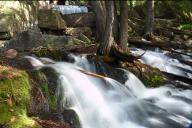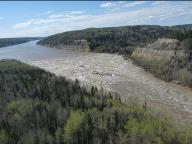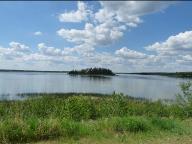|
Current scientific programs |
|
Past scientific programs |













|
Craig A. Emmerton, Ph.D. |


|
Project |
Collaborators |
Affiliation |
Summary |
|
Geospatial patterns of mercury in fish of Alberta lakes |
Dr. J. Graydon M. Reichert Dr. P. Drevnick C. Donadt |
Gov. of Alberta Gov. of Alberta Gov. of Alberta Gov. of Alberta |
We are using geospatial approaches to assess associations between mercury concentrations in fish and watershed-scale geospatial data to better understand controlling factors on fish mercury accumulation in lakes across Alberta. |
|
From the mountains to our tables: freshwater security in three Canadian Eastern Rocky Mountain watersheds |
Dr. R. Vinebrooke Dr. S. Tank Dr. M. Bhatia Dr. V. St. Louis J. Serbu |
U. of Alberta U. of Alberta U. of Alberta U. of Alberta U. of Alberta |
As part of the Canadian Mountain Network Centres of Excellence NSERC grant, this work will assess the water quality and ecological condition of mountain rivers which are the sources of drinking water for over 2 million people in Alberta. |
|
Development of a geospatial tool for assessing watershed integrity and aquatic ecosystem health in the North Saskatchewan River basin |
Dr. C. Buendia-Fores Dr. F. Wyatt Dr. R. Vinebrooke Dr. S. Green Dr. M. Bhatia |
Gov. of Alberta Gov. of Alberta U. of Alberta U. of Alberta U. of Alberta |
This work, funded by the Alberta Innovates Water Innovation Program, seeks to develop a geospatial model for assessing watershed integrity and aquatic ecosystem health in streams and rivers across the North Saskatchewan River basin. |
Greenhouse gases exchange of post-wildfire boreal peatlands |
Dr. D. Olefeldt C. Schulze |
U. of Alberta U. of Alberta |
This project quantifies ecosystem recovery of boreal peatlands following wildfires using eddy covariance and other gas exchange measurements. |
|
Coal mining impacts on surface waters of Alberta’s Rocky Mountain headwater regions |
Dr. C. Cooke Dr. P. Drevnick |
Gov. of Alberta Gov. of Alberta |
Coal mining in Alberta’s Rocky Mountains has had quantifiable impacts on surface water quality and fish communities in the region. Here we assess recovery of water quality in coal-impacted streams following closure of coal mining operations. |
|
Tracking and forecasting of harmful algal blooms in Alberta using remote-sensing techniques under a changing climate |
Dr. R. Vinebrooke Dr. R. Zurawell Dr. C. McClain Dr. J. Graydon |
University of Alberta Government of Alberta Alberta Biomonitoring Institute Government of Alberta |
Cyanobacteria harmful algae blooms (cHABs) cause widespread ecological and socio-economic impacts on Alberta lakes. We are using satellite-based and field-based assessments to improve accuracy of cHAB extents and intensities in selected lakes across Alberta to improve cHAB forecasting and to protect lake users. |
|
Project |
Summary |
|
Mercury and methylmercury export from diverse headwater catchments of major Canadian river systems |
This project assesses the mercury and methylmercury concentrations , export and yields of diverse headwater landscapes of major western Canadian rivers. Publications: Emmerton et al., 2023 |
|
Impacts of the 2016 Fort McMurray wildfire on riverine water quality |
Following the devastating 2016 Fort McMurray wildfire in western Canada, we initiated a multi-faceted water quality monitoring program to quantify the impacts of the fire on the water quality of large, low-relief rivers . Publications: Emmerton et al., 2020, Cooke et al., 2022 |
Greenhouse gases exchange of Alberta grasslands |
Using eddy covariance and other field measurements, we assessed the utility of remote sensing to remotely quantify the productivity and seasonal greenhouse gas exchange of southern Alberta grasslands and the impacts of human-related stresses on these processes. Publications: Wang et al., 2020, 2016; Nestola et al., 2016 |
|
Acid-sensitive lakes in Canada’s Oil Sands Region |
This long-term project assesses the biogeochemistry of a 50-lake set surrounding Canada’s Oil Sands region and the impact industry may have on the functioning of these ecosystems. Publications: Emmerton et al., 2018 |
|
The biogeochemistry of the world’s largest high Arctic lake and its responses to rapid climate change |
The largest lake in the high Arctic is experiencing rapid climate change due to anthropogenic warming related to greenhouse gases emissions. This project is quantifying these impacts across a range of ecosystem compartments in the lake including water, sediments, and important ecosystem food webs. Publications: Lehnherr et al., 2018, 2012 |
|
Long-term assessment of Boreal shield watershed and lake biogeochemistry in response to ongoing climate impacts. |
Water, carbon and nutrient cycles in headwater boreal watersheds may change substantially in response to climate-related changes including increasing rainfall and impacts from wildfire. This work quantifies long-term changes in biogeochemical cycles in river and lake ecosystems in response to these human-related stressors. Publications: Emmerton et al., 2019; Hall et al., 2019 |
|
The net exchange of carbon greenhouse gases with remote polar desert and wetland landscapes on northern Ellesmere Island, Nunavut, Canada |
This research program assesses the net ecosystem exchange (NEE) of carbon dioxide (CO2) and methane (CH4) between the atmosphere and terrestrial and aquatic landscapes near Lake Hazen, Nunavut, the most northerly site ever studied (82oN). Publications: Emmerton et al., 2014, 2016a, 2016b, Oh et al., 2016, Virkkala et al., 2021, a.b. |
|
Mercury dynamics in the Mackenzie River, delta and estuary |
We sampled surface waters from the lower Mackenzie River for total Hg and MeHg since 2004 to help establish a long-term dataset of Hg delivery from the Mackenzie River. We have collaborated with researchers from the International Polar Year Project Study of Canadian Arctic River-delta Fluxes (IPY-SCARF) to quantify annual Hg fluxes to the Beaufort Sea. Publications: Chetelat et al., 2015; Emmerton et al., 2013,; Graydon et al., 2009 |
|
Downstream nutrient changes through the Mackenzie River delta and estuary |
This research program quantifies open water nutrient fluxes and the role of the lake-rich Mackenzie River delta in storing and biogeochemically altering river water before discharge to the ocean. Nutrient changes across the full salinity transition of the Mackenzie River estuary are also investigated and evaluated with respect to the unique coastal conditions of the Mackenzie Shelf region (Arctic-River Delta Experiment) Publications: Emmerton et al., 2008a, 2008b, 2007 |
|
Mercury Experiment To Assess Atmospheric Loading In Canada and the United States |
Assess the role of increasing mercury deposition on methylmercury concentrations in fish through a novel stable isotope loading approach at the whole-ecosystem level. Publications: St. Louis et al., 2019; Graydon et al., 2012; |